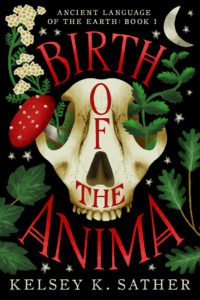 Birth of the Anima, Kelsey K. Sather’s debut novel, is an ambitious ecological myth in the vein of J.R.R. Tolkien’s Middle Earth books, with extensive lore and dozens upon dozens of characters that interweave throughout the narrative. Actually, it reads out less like a singular narrative and more like an anthology of interconnected short stories surrounding the twelve generations of the Anima, women who receive beast-like abilities and the gift of communicating with the natural world. These women are tasked with ending the wanton destruction of the planet by the human hands of the Imperium, the global empire that takes all it can, regardless of who or what pays the price.
Birth of the Anima, Kelsey K. Sather’s debut novel, is an ambitious ecological myth in the vein of J.R.R. Tolkien’s Middle Earth books, with extensive lore and dozens upon dozens of characters that interweave throughout the narrative. Actually, it reads out less like a singular narrative and more like an anthology of interconnected short stories surrounding the twelve generations of the Anima, women who receive beast-like abilities and the gift of communicating with the natural world. These women are tasked with ending the wanton destruction of the planet by the human hands of the Imperium, the global empire that takes all it can, regardless of who or what pays the price.
Where this book shines is in its lyrical prose describing the natural world. Sather has created an expansive land with a rich history and diverse biomes, including rivers, mountains, forests, and valleys. It is almost as if Sather is not just describing the natural world, but is putting the soul of the land on the page.
The ambition and scope of “Birth of the Anima” is not only the novel’s greatest strength but also its greatest weakness. The narrative of the “main” character, Freda, often takes a back seat to the preceding Anima, although these stories and hers do intersect towards the end. It is frustrating to expect to follow one character’s story, only for it to be forgotten about for much of the book. Freda also has the least personal reason for going down her path, basically being compelled to do so simply because a mysterious scroll sends her in that direction. The Anima before her all have much more personal reasons to take up the mantle, so it feels like they have something at stake, which makes readers feel more of a personal investment in their stories.
A cool plus of this novel is the LGBTQ+ representation. Freda is attracted to women, and several of her allies along the journey are either gay or lesbian. Even with this said, sometimes the writing gets a little risqué, so that should be known going in.
In spite of the book’s shortcomings, it is worth reading for those who can tolerate the often erratic and sluggish pacing. It is a message that the human race needs to hear: coexist with the natural world, or face extinction.
To learn more about Birth of the Anima, visit the author’s website, which includes some maps of the book’s world.
Terrence J. Smith is MetaStellar's assistant fiction editor. He has contributed his writing to nonprofits and both print and digital publications. He enjoys all things technology, but remembers to meditate and appreciate the outside world.

